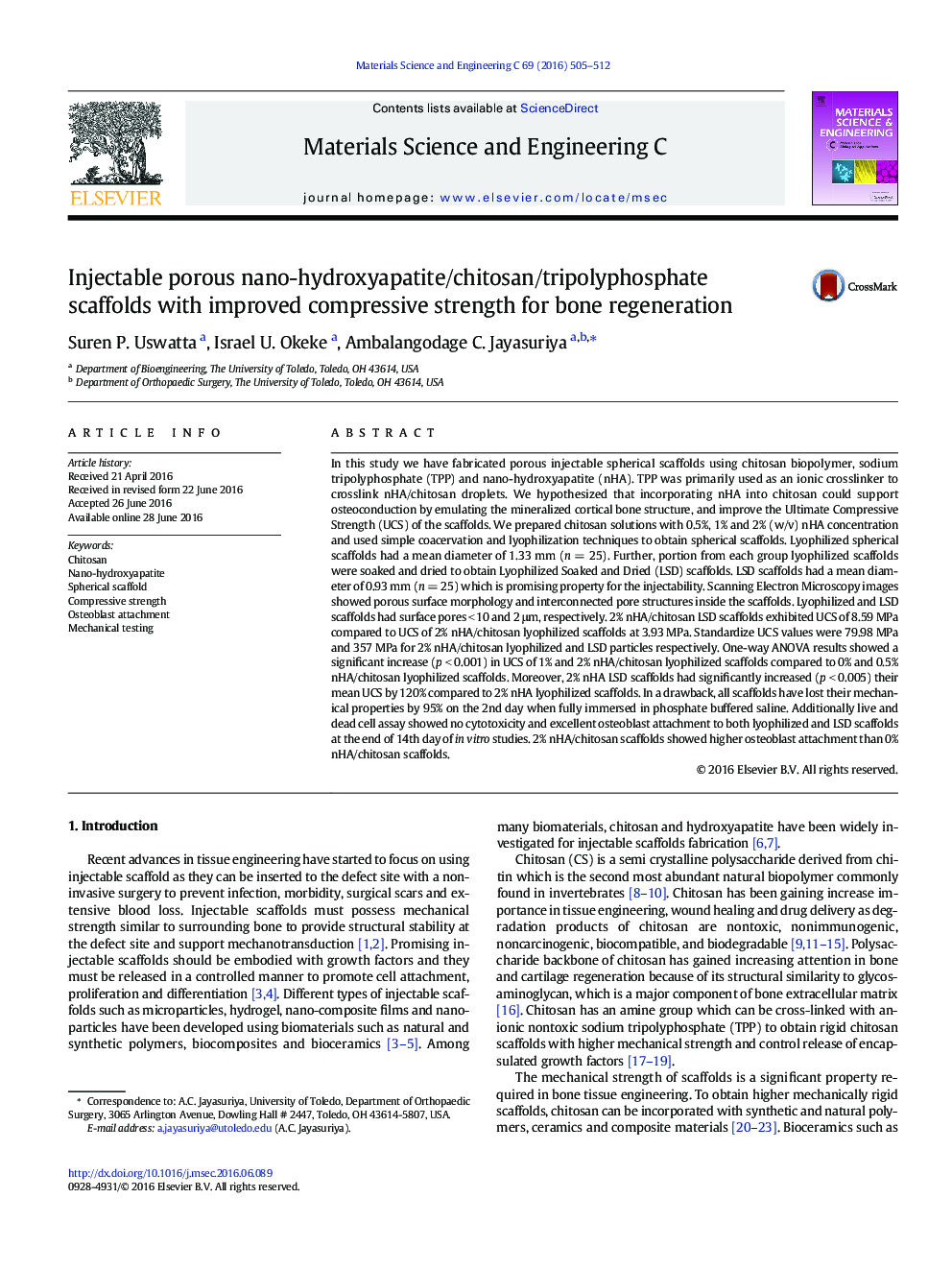| کد مقاله | کد نشریه | سال انتشار | مقاله انگلیسی | نسخه تمام متن |
|---|---|---|---|---|
| 1427881 | 1509152 | 2016 | 8 صفحه PDF | دانلود رایگان |
• Injectable porous scaffolds prepared from chitosan and nano-hydroxyapatite.
• Scaffolds are fabricated using non-toxic coacervation and lyophilization techniques.
• 2% nHA/chitosan scaffolds exhibited the highest ultimate compressive strength.
• Scaffolds' compressive strength can be increased by simple soaking and drying.
• Scaffolds showed very good osteoblast adhesion and proliferation.
In this study we have fabricated porous injectable spherical scaffolds using chitosan biopolymer, sodium tripolyphosphate (TPP) and nano-hydroxyapatite (nHA). TPP was primarily used as an ionic crosslinker to crosslink nHA/chitosan droplets. We hypothesized that incorporating nHA into chitosan could support osteoconduction by emulating the mineralized cortical bone structure, and improve the Ultimate Compressive Strength (UCS) of the scaffolds. We prepared chitosan solutions with 0.5%, 1% and 2% (w/v) nHA concentration and used simple coacervation and lyophilization techniques to obtain spherical scaffolds. Lyophilized spherical scaffolds had a mean diameter of 1.33 mm (n = 25). Further, portion from each group lyophilized scaffolds were soaked and dried to obtain Lyophilized Soaked and Dried (LSD) scaffolds. LSD scaffolds had a mean diameter of 0.93 mm (n = 25) which is promising property for the injectability. Scanning Electron Microscopy images showed porous surface morphology and interconnected pore structures inside the scaffolds. Lyophilized and LSD scaffolds had surface pores < 10 and 2 μm, respectively. 2% nHA/chitosan LSD scaffolds exhibited UCS of 8.59 MPa compared to UCS of 2% nHA/chitosan lyophilized scaffolds at 3.93 MPa. Standardize UCS values were 79.98 MPa and 357 MPa for 2% nHA/chitosan lyophilized and LSD particles respectively. One-way ANOVA results showed a significant increase (p < 0.001) in UCS of 1% and 2% nHA/chitosan lyophilized scaffolds compared to 0% and 0.5% nHA/chitosan lyophilized scaffolds. Moreover, 2% nHA LSD scaffolds had significantly increased (p < 0.005) their mean UCS by 120% compared to 2% nHA lyophilized scaffolds. In a drawback, all scaffolds have lost their mechanical properties by 95% on the 2nd day when fully immersed in phosphate buffered saline. Additionally live and dead cell assay showed no cytotoxicity and excellent osteoblast attachment to both lyophilized and LSD scaffolds at the end of 14th day of in vitro studies. 2% nHA/chitosan scaffolds showed higher osteoblast attachment than 0% nHA/chitosan scaffolds.
Figure optionsDownload as PowerPoint slide
Journal: Materials Science and Engineering: C - Volume 69, 1 December 2016, Pages 505–512
